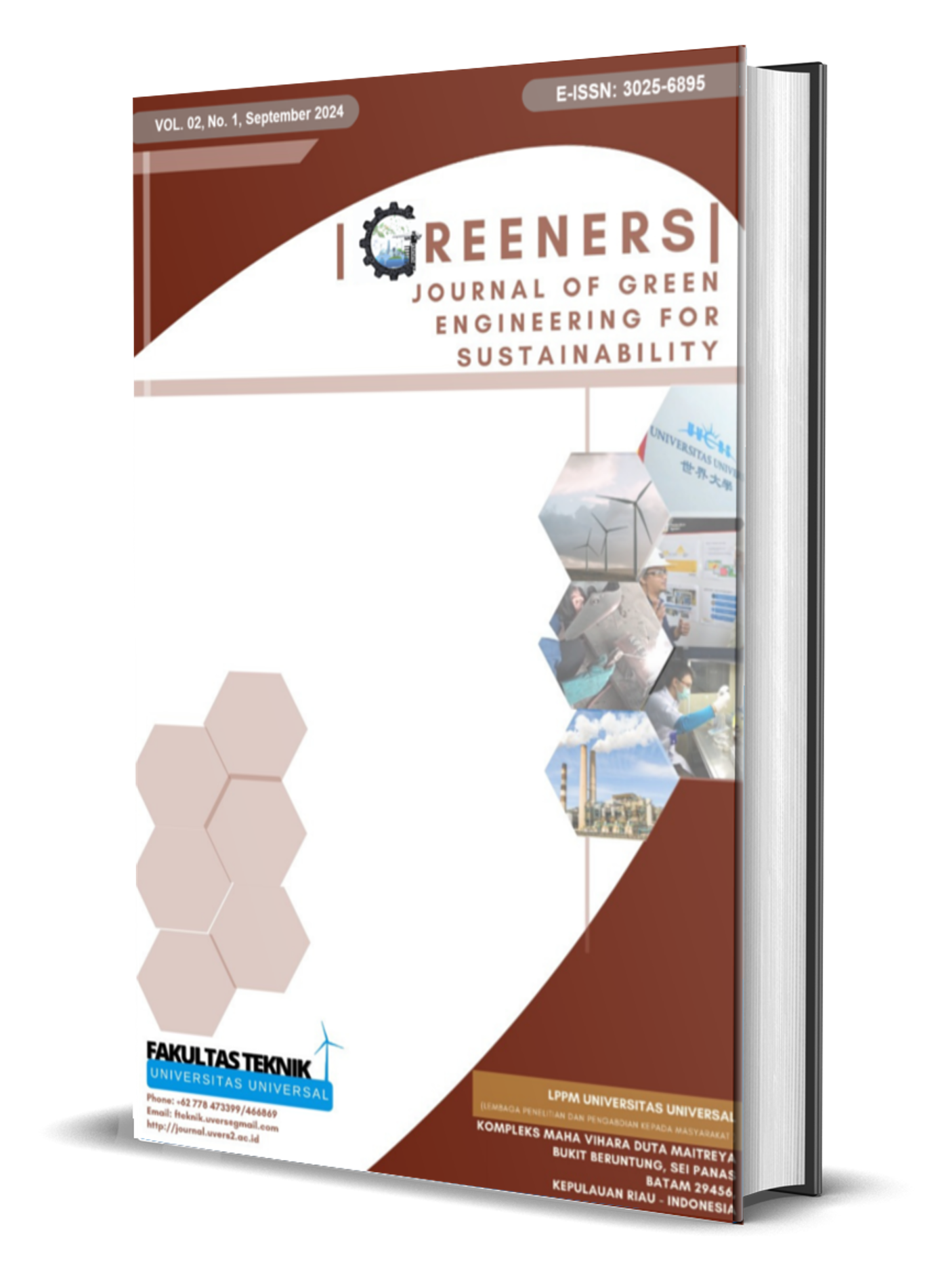Analisis Implementasi Reverse Logistics untuk Meningkatkan Efisiensi Biaya dalam Pengelolaan Limbah Medis di Klinik Kesehatan
DOI:
https://doi.org/10.63643/jges.v3i1.301Kata Kunci:
Reverse Logistics, Cost Efficiency, Medical Waste, Health ClinicAbstrak
Pengelolaan limbah medis merupakan tantangan utama dalam sistem kesehatan, terutama dalam memastikan efisiensi biaya sekaligus meminimalkan dampak lingkungan. Penelitian ini bertujuan untuk menganalisis hubungan antara penerapan reverse logistics dan efisiensi biaya pengelolaan limbah medis di klinik kesehatan. Metodologi yang digunakan adalah pendekatan kuantitatif dengan sampel sebanyak 36 responden yang terlibat dalam pengelolaan limbah medis. Data dikumpulkan menggunakan kuesioner, dan dianalisis menggunakan uji Chi-Square untuk mengevaluasi hubungan antar variabel. Hasil penelitian menunjukkan adanya hubungan yang signifikan antara penerapan reverse logistics dengan efisiensi biaya, di mana implementasi yang lebih baik dari reverse logistics mampu mengurangi pengeluaran operasional secara substansial. Kesimpulan dari penelitian ini mengindikasikan bahwa pengelolaan limbah medis melalui reverse logistics tidak hanya efektif dalam meningkatkan efisiensi biaya, tetapi juga mendukung keberlanjutan lingkungan. Implikasi praktis dari temuan ini dapat menjadi acuan bagi pengelola klinik kesehatan dalam merancang strategi pengelolaan limbah yang lebih efisien.
Referensi
Dinas Kesehatan Kota Padang, Laporan tahunan pengelolaan limbah medis di Kota Padang. Padang: DKK Padang, 2022.
Kementerian Kesehatan Republik Indonesia (Kemenkes RI), Pedoman pengelolaan limbah medis fasilitas pelayanan kesehatan. Jakarta: Kementerian Kesehatan RI, 2021.
K. Hawks, “What is Reverse Logistics,” Reverse Logistics Magazine, 2016.
A. Ergülen, F. S. Özdemir, M. Gokmen, and Z. Ünal, “A Case Study of Recycle Based Reverse Logistics Cost Minimization,” J. Basic Appl. Res. Int., vol. 9, 2015.
F. Aini, “PENGELOLAAN SAMPAH MEDIS RUMAH SAKIT ATAU LIMBAH B3 (BAHAN BERACUN DAN BERBAHAYA) DI SUMATERA BARAT,” 2019.
A. M. Asrun, L. A. Sihombing, and Y. Nuraeni, “DAMPAK PENGELOLAAN SAMPAH MEDIS DIHUBUNGKAN DENGAN UNDANG-UNDANG No 36 TAHUN 2009 TENTANG KESEHATAN DAN UNDANG-UNDANG No. 32 TAHUN 2009 TENTANG PERLINDUNGAN DAN PENGELOLAAN LINGKUNGAN HIDUP,” 2020.
N. A. Foci, E. Amrina, and A. Hasan, “The Effect of Employee Engagement on Employee Performance in Private Agencies : The Moderation Influence of Employee ’ s Generational Characteristics,” vol. 13, no. 2, pp. 75–90, 2024.
T. O. Adesoga, O. P. Olaiya, E. P. Onuma, O. Ajayi, and O. D. Olagunju, “Review of reverse logistics practices and their impact on supply chain sustainability,” 2024.
T. K. Eltayeb, S. Zailani, and T. Ramayah, “Green supply chain initiatives among certified companies in Malaysia and environmental sustainability: Investigating the outcomes,” Resour. Conserv. Recycl., vol. 55, no. 5, pp. 495–506, 2011, doi: https://doi.org/10.1016/j.resconrec.2010.09.003.
S. Farisha and A. S. Putra, “Strategi Inovasi Semen Padang Hospital Dalam Peningkatan Produk Layanan Pada Masa Pandemi Covid-19,” vol. 6, no. 1, pp. 26–33, 2023.
D. S. Rogers and R. S. Tibben-Lembke, “An Examination of Reverse Logistics Practices,” Journal of Business Logistics, vol. 22, no. 2, pp. 129–148, 2001.
K. Govindan, M. Soleimani, and D. Kannan, “Reverse logistics and closed-loop supply chain: A comprehensive review to explore the future,” European Journal of Operational Research, vol. 240, no. 3, pp. 603–626, 2015.
T. McGain and C. Naylor, “Environmental sustainability in hospitals – a systematic review and research agenda,” Journal of Health Services Research & Policy, vol. 19, no. 4, pp. 245–252, 2014.
M. Zare, S. Maknoon, and M. H. Shirazi, “Integrated healthcare waste management model using life cycle assessment and multi-criteria decision making,” Waste Management, vol. 69, pp. 112–123, 2017.
B. S. Wilcox, “Cost-efficiency strategies in medical waste treatment,” International Journal of Health Economics, vol. 14, no. 2, pp. 122–131, 2015.
M. I. Salema, A. P. Barbosa-Póvoa, and A. Q. Novais, “An optimization model for the design of a capacitated multi-product reverse logistics network with uncertainty,” European Journal of Operational Research, vol. 179, no. 3, pp. 1063–1077, 2007.
A. K. Yadav, M. K. Tiwari, and R. Shankar, “Modeling the enablers of reverse logistics: A fuzzy DEMATEL approach,” Benchmarking: An International Journal, vol. 25, no. 5, pp. 1422–1444, 2018.
A. Ravi and R. Shankar, “Analysis of interactions among the barriers of reverse logistics,” Technological Forecasting and Social Change, vol. 72, no. 8, pp. 1011–1029, 2005.
S. Kumar and G. Dixit, “Evaluating the barriers of green and reverse logistics: a DEMATEL approach,” Procedia - Social and Behavioral Sciences, vol. 189, pp. 395–403, 2015.
M. A. Brown and e. al, "Energy efficiency: Technologies and policies," Annual Review of Environment and Resources, vol. 43, pp. 353-381, 2018.
P. H. Gleick, "The World's Water Volume 8: The Biennial Report on Freshwater Resources," Island Press, 2018.
Q. Zhu and et al., "The impact of institutional pressures on supplier development practices: Evidence from Chinese manufacturing firms.," International Journal of Production Economics, vol. 171, pp. 222-232, 2016.
B. Jacobs, "The impact of cross-functional integration on performance: The moderating role of climate for innovation," International Journal of Production Economics, vol. 205, pp. 168-177, 2018.
A. Prüss-Ustün and et al., "Safe management of wastes from health-care activities.," World Health Organization, 2019.
A. Kharrazi and et al., "Quantifying policies for sustainable urban environmental systems: An integrated environmental and economic assessment in Vienna," Sustainable Cities and Society, vol. 20, pp. 256-263, 2016.
M. Geissdoerfer and et al., "The circular economy – A new sustainability paradigm," Journal of Cleaner Production, vol. 143, pp. 757-768, 2017.
M. P. Wilson and B. L. Jones, "Chemical safety: International reference manual," in Springer, 2016.
F. Dahlmann and et al., "Corporate environmental strategy: Towards a framework for sustainable business," Business Strategy and the Environment, vol. 28, pp. 446-465, 2019.
S. Zhou and et al., "Health care waste management in Asia," a. International Journal of Environmental Research and Public Health, vol. 14, no. 11, p. 1472, 2017.
S. Yoon and J. Hwang, "Development of an integrated energy efficiency and greenhouse gas emission reduction strategy for medical facilities," Energy, vol. 149, pp. 341-352, 2018.
G. M. Kane and et al., "Circular economy solutions to close the loop on e-waste: A critical review," Journal of Cleaner Production, vol. 236, p. 117612, 2019.
J. A. Patterson and J. Patrick, "Medical equipment management in a developing economy: The case of Ghana," Global Health Action, vol. 10, no. 1, p. 1334590, 2017.
L. A. Y. Al-Hakim and C. Jin, "Performance evaluation of manufacturing industries: An integrated approach based on dynamic network DEA and neural networks," Journal of the Operational Research Society, vol. 1, no. 70, pp. 1-14, 2019.
B. T. Hazen, J. Huscroft, D. J. Hall, F. K. Weigel, and J. B. Hanna, “Reverse logistics information system success and the effect of motivation,” Int. J. Phys. Distrib. Logist. Manag., vol. 44, no. 3, pp. 201–220, Jan. 2014, doi: 10.1108/IJPDLM-11-2012-0329.
J. F. Hair, W. C. Black, B. J. Babin, and R. E. Anderson, Multivariate Data Analysis, 8th ed. Boston, MA: Cengage Learning, 2019.
Unduhan
Diterbitkan
Cara Mengutip
Terbitan
Bagian
Lisensi
Hak Cipta (c) 2025 Nia Arfina Foci, Rahmi M Nur, Syafira Salsabila, Muhamad Yasin, M Arif Munanda

Artikel ini berlisensiCreative Commons Attribution-ShareAlike 4.0 International License.
















